A Single-Clamp Inchworm Actuator with Two Piezoelectric Stacks
Abstract
:1. Introduction
2. Structures and Working Principle
2.1. Structures of the Actuator and Roles of Each Mechanism
2.2. Working Principle
3. Results and Discussion
3.1. Mechanical Modeling and Analysis of Actuators
3.1.1. Physical Analysis
3.1.2. Parameter Selection
3.1.3. Simulation Analysis
3.2. Experimental Evaluation
3.2.1. Control Waveform Design
3.2.2. Output Characteristic Evaluation
3.2.3. Output Characteristic Evaluation of the Inchworm Actuator
3.3. Comparison
4. Conclusions
Author Contributions
Funding
Data Availability Statement
Conflicts of Interest
References
- Zhang, S.; Liu, Y.; Deng, J.; Gao, X.; Li, J.; Wang, W.; Xun, M.; Ma, X.; Chang, Q.; Liu, J.; et al. Piezo robotic hand for motion manipulation from micro to macro. Nat. Commun. 2023, 14, 500. [Google Scholar] [CrossRef] [PubMed]
- Elahi, H.; Munir, K.; Eugeni, M.; Abrar, M.; Khan, A.; Arshad, A.; Gaudenzi, P. A Review on Applications of Piezoelectric Materials in Aerospace Industry. Integr. Ferroelectr. 2020, 211, 25–44. [Google Scholar] [CrossRef]
- Du, P.; Liu, Y.; Deng, J.; Yu, H.; Chen, W. A Compact Ultrasonic Burnishing System for High Precision Planar Burnishing: Design and Performance Evaluation. IEEE Trans. Ind. Electron. 2022, 69, 8201–8211. [Google Scholar] [CrossRef]
- Oh, C.H.; Choi, J.H.; Nam, H.J.; Bu, J.U.; Kim, S.H. Ultra-compact, zero-power magnetic latching piezoelectric inchworm motor with integrated position sensor. Sens. Actuators A Phys. 2010, 158, 306–312. [Google Scholar] [CrossRef]
- Jungin, Y.; Sangjun, J. Wide temperature operation of piezoelectric sensors for detecting precursor levels in a canister. Meas. Sci. Technol. 2023, 34, 065117. [Google Scholar]
- Ma, X.; Liu, J.; Deng, J.; Liu, Q.; Liu, Y. A Rotary Traveling Wave Ultrasonic Motor with Four Groups of Nested piezoelectric stack Ceramics: Design and Performance Evaluation. IEEE Trans. Ultrason. Ferroelectr. Freq. Control. 2020, 67, 1462–1469. [Google Scholar] [CrossRef] [PubMed]
- Wang, D.; Zhao, K.; Yuan, Y.; Wang, Z.; Zong, H.; Zhang, X.; Liang, J. Fabrication and Characterization of a Microscale Piezoelectric Vibrator Based on Electrohydrodynamic Jet Printed piezoelectric stack Thick Film. Micromachines 2021, 12, 524. [Google Scholar] [CrossRef]
- Li, J.; Liu, Y.; Deng, J.; Zhang, S.; Chen, W. Development of a Linear Piezoelectric Microactuator Inspired by the Hollowing Art. IEEE Trans. Ind. Electron. 2022, 69, 10407–10416. [Google Scholar] [CrossRef]
- Qiu, J.; Yang, Y.; Hong, X.; Vasiljev, P.; Mazeika, D.; Borodinas, S. A Disc-Type High Speed Rotary Ultrasonic Motor with Internal Contact Teeth. Appl. Sci. 2021, 11, 2386. [Google Scholar] [CrossRef]
- Xu, Z.; Yang, Z.; Wang, K.; Li, X.; Liu, Y.; Dong, J.; Huang, H. A bionic inertial piezoelectric actuator with improved frequency bandwidth. Mech. Syst. Signal Process. 2021, 156, 107620. [Google Scholar] [CrossRef]
- Wang, J.; Qin, F.; Li, L.; Liu, Z.; Zhao, H. A linear piezoelectric actuator with high flexibility flexible mechanism designed by the bidirectional parasitic motion principle. Rev. Sci. Instrum. 2020, 91, 045005. [Google Scholar] [CrossRef] [PubMed]
- Ma, L.; Jiang, C.; Xiao, J.; Wang, K.; Xie, W.; Liu, B. A piezoelectric inchworm actuator based on the principle of flexible amplification. In Proceedings of the 2013 International Conference on Manipulation, Manufacturing and Measurement on the Nanoscale, Suzhou, China, 26–30 August 2013; pp. 201–206. [Google Scholar]
- Tian, X.; Quan, Q.; Wang, L.; Su, Q. An Inchworm Type Piezoelectric Actuator Working in Resonant State. IEEE Access 2018, 6, 18975–18983. [Google Scholar] [CrossRef]
- Neves, P.T.; Bavastri, C.A.; Pereira, J.T.; Oliveira, R.A.; Pohl, A.A.P.; Boni, D.A.; Luersen, M.A. Fiber Bragg grating tuning with notch-type spring device. Meas. Sci. Technol. 2011, 22, 085303. [Google Scholar] [CrossRef]
- Choi, S.B.; Han, S.S.; Lee, Y.S. Fine motion control of a moving stage using a piezoactuator associated with a displacement amplifier. Smart Mater. Struct. 2004, 14, 222. [Google Scholar] [CrossRef]
- Scire, F.E.; Teague, E.C. Piezodriven 50 μm range stage with subnanometer resolution. Rev. Sci. Instrum. 1978, 49, 1735–1740. [Google Scholar] [CrossRef] [PubMed]
- Wang, S.; Zhou, S.; Zhang, X.; Xu, P.; Zhang, Z.; Ren, L. Bionic Stepping Motors Driven by Piezoelectric Materials. J. Bionic Eng. 2022, 20, 858–872. [Google Scholar] [CrossRef]
- Mohammad, T.; Salisbury, S.P. Design and Assessment of a Z-Axis Precision Positioning Stage with Centimeter Range Based on a Piezoworm Motor. IEEE/ASME Trans. Mechatron. 2015, 20, 2021–2030. [Google Scholar] [CrossRef]
- Dong, H.; Li, T.; Wang, Z.; Ning, Y. Design and experiment of a piezoelectric actuator based on inchworm working principle. Sens. Actuators A Phys. 2020, 306, 111950. [Google Scholar] [CrossRef]
- Wang, Y.; Yan, P. A novel bidirectional complementary-type inchworm actuator with parasitic motion based clamping. Mech. Syst. Signal Process. 2019, 134, 106360. [Google Scholar] [CrossRef]
- Ma, X.; Liu, Y.; Deng, J.; Zhang, S.; Liu, J. A walker-pusher inchworm actuator driven by two piezoelectric stacks. Mech. Syst. Signal Process. 2021, 169, 108636. [Google Scholar] [CrossRef]
- Liu, G.; Zhang, Y.; Liu, J.; Li, J.; Tang, C.; Wang, T.; Yang, X. An Unconventional Inchworm Actuator Based on piezoelectric stack/ERFs Control Technology. Appl. Bionics Biomech. 2016, 2016, 2804543. [Google Scholar] [CrossRef] [PubMed]
- Lu, Q.; Ma, J.; Lin, X.; Hu, Y.; Li, J.; Wen, J. The Development of Piezoelectric Inchworm Actuator Clamped with Magnetorheological Elastomer and Its Potential Application in Brain–Computer Interface Implantation. IEEE Trans. Ind. Electron. 2023, 70, 4018–4026. [Google Scholar] [CrossRef]
- Wang, R.; Hu, Y.; Shen, D.; Ma, J.; Li, J.; Wen, J. A Novel Piezoelectric Inchworm Actuator Driven by One Channel DC Signal. IEEE Trans. Ind. Electron. 2020, 68, 2015–2023. [Google Scholar] [CrossRef]
- Deng, J.; Zhang, S.; Li, Y.; Ma, X.; Gao, X.; Xie, H.; Liu, Y. Development and experiment evaluation of a compact inchworm piezoelectric actuator using three-jaw type clamping mechanism. Smart Mater. Struct. 2022, 31, 045020. [Google Scholar] [CrossRef]

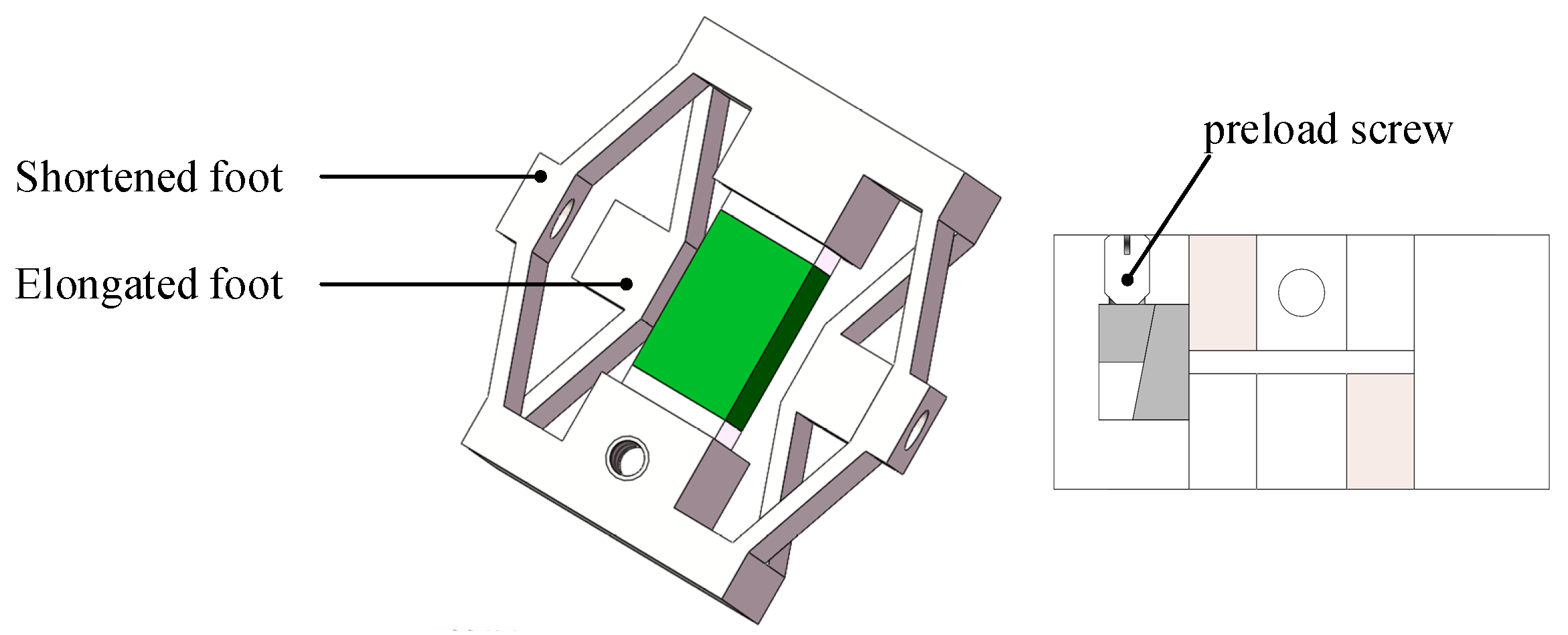
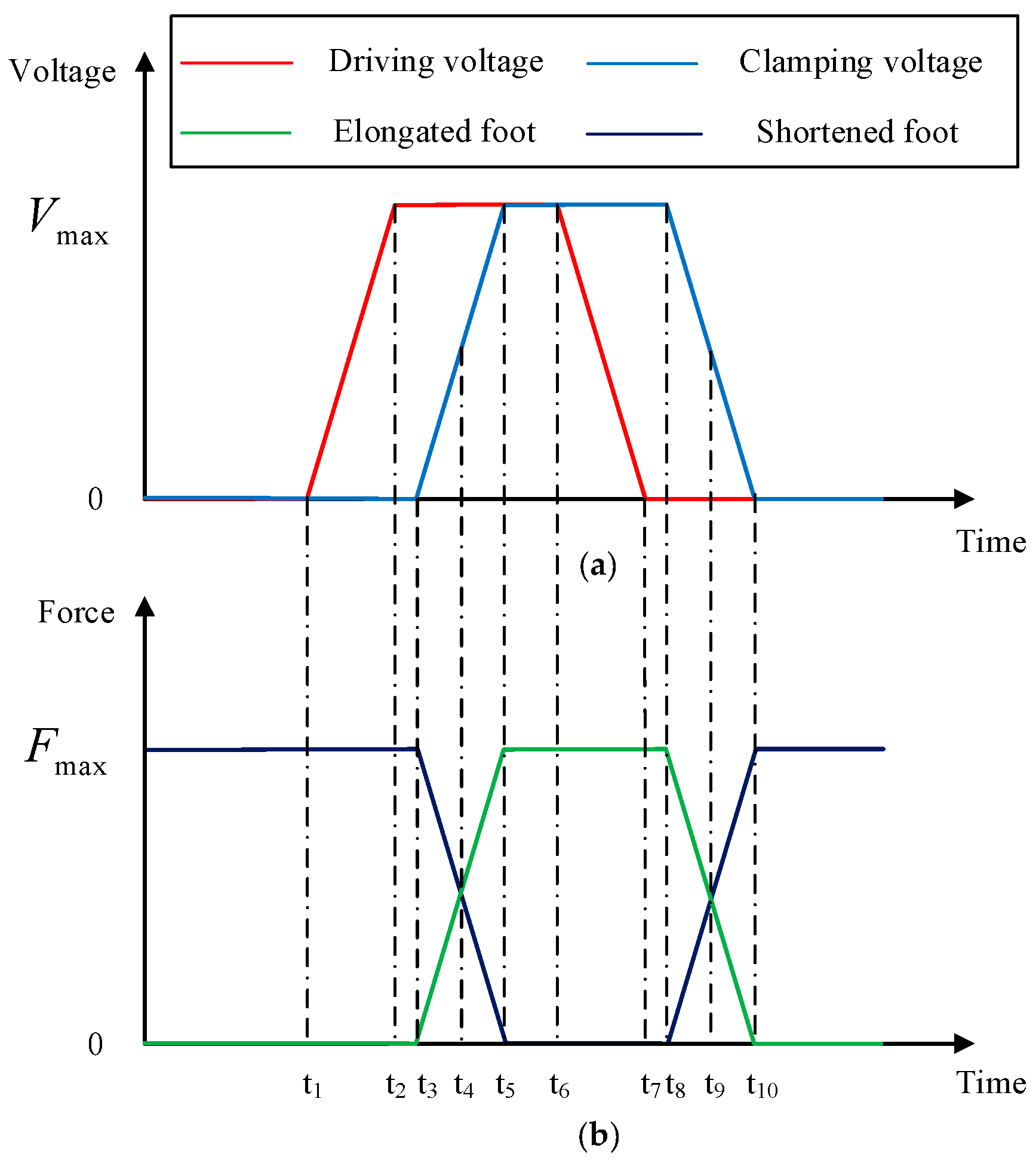


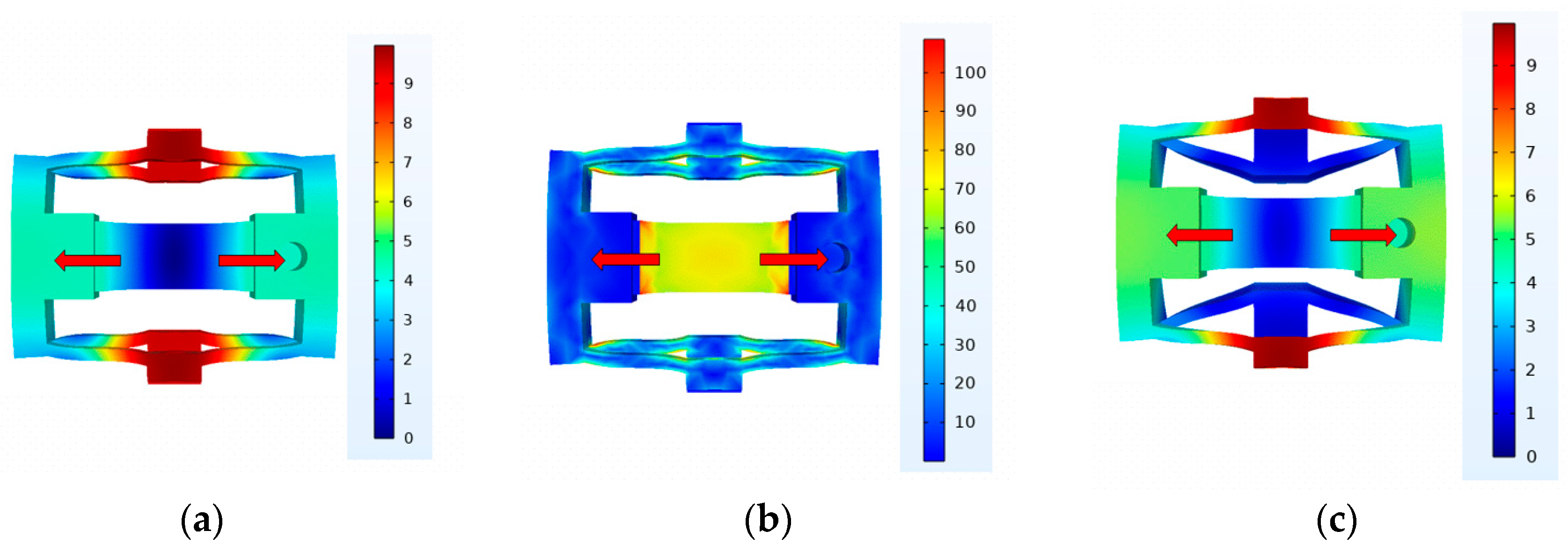


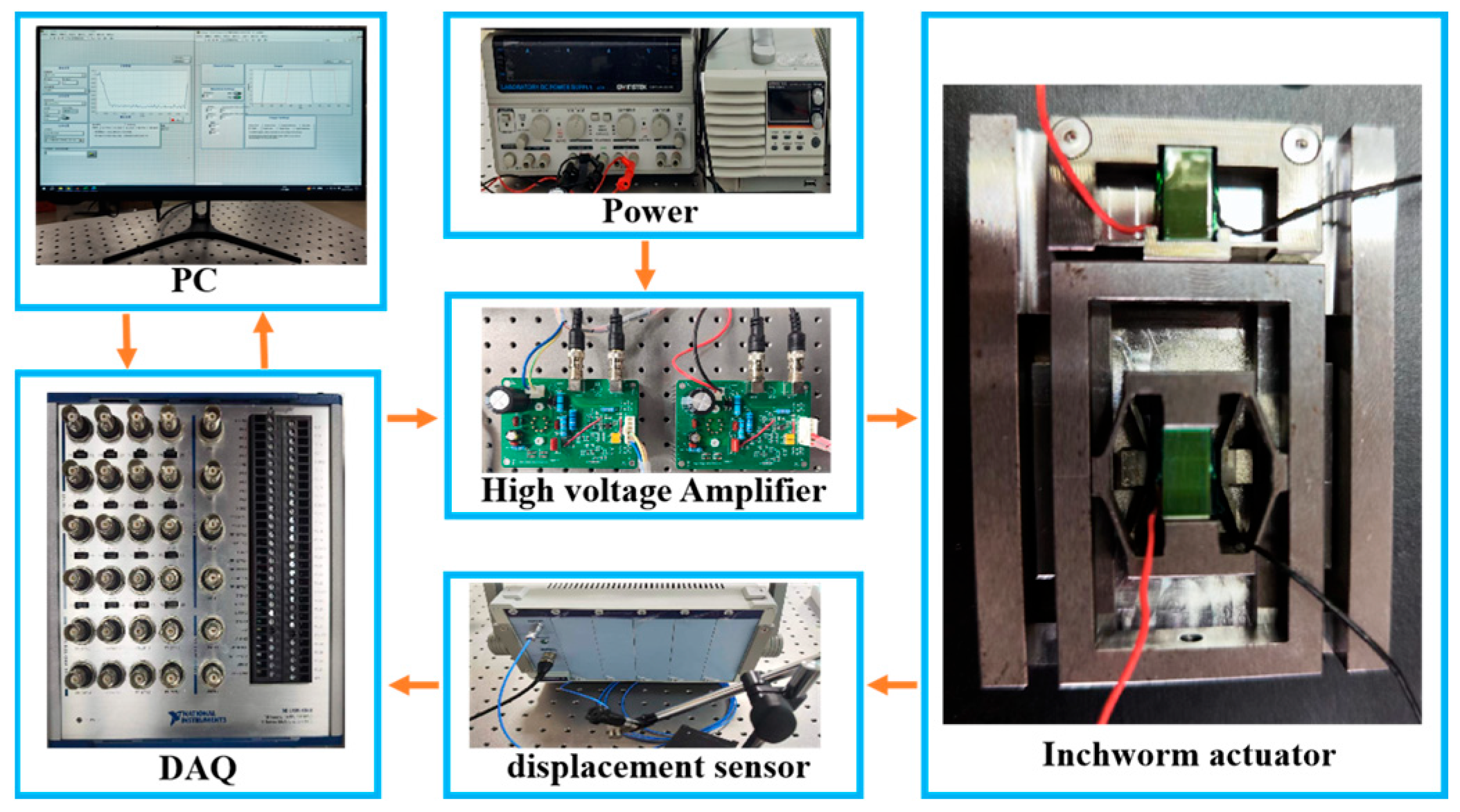
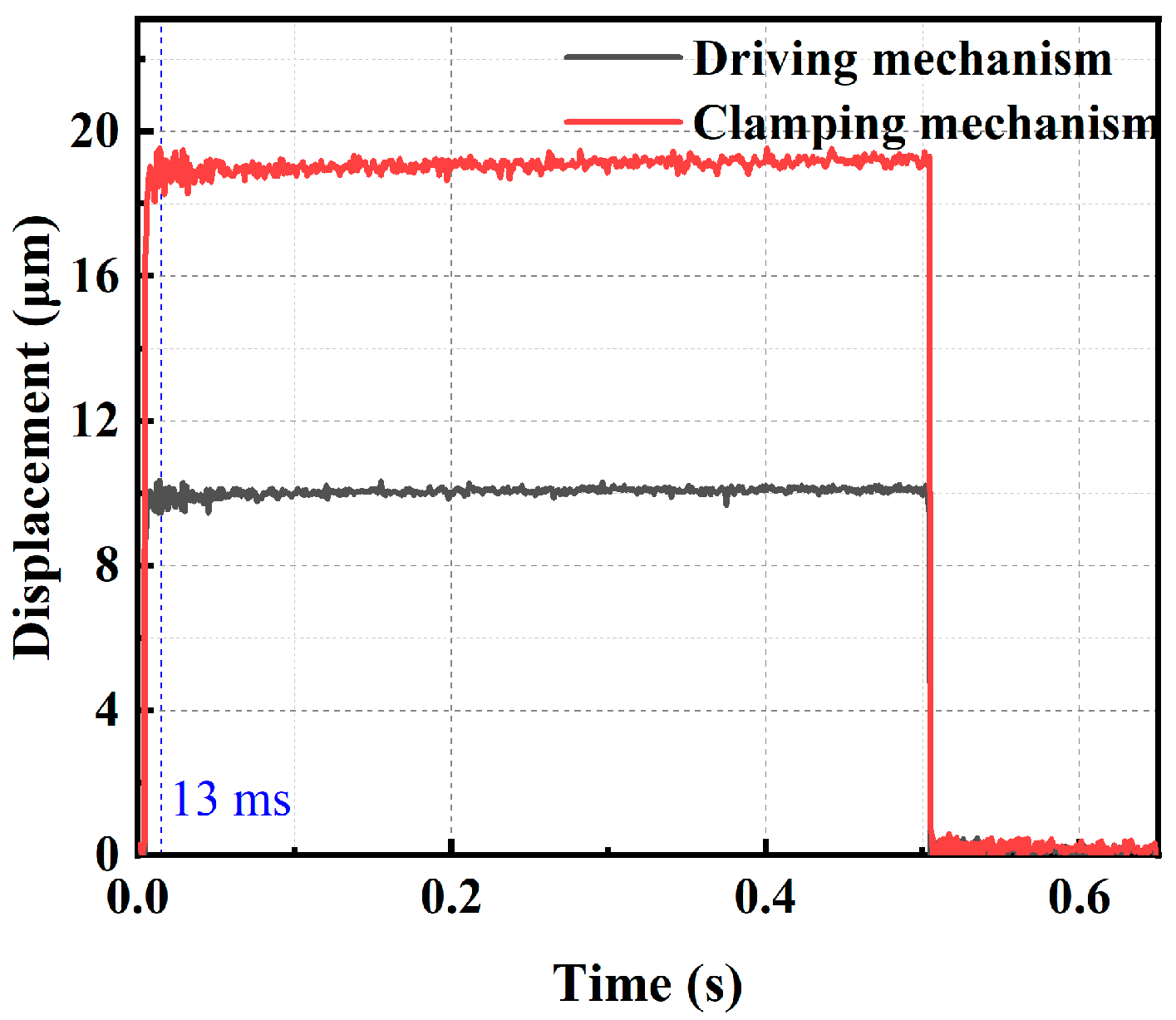
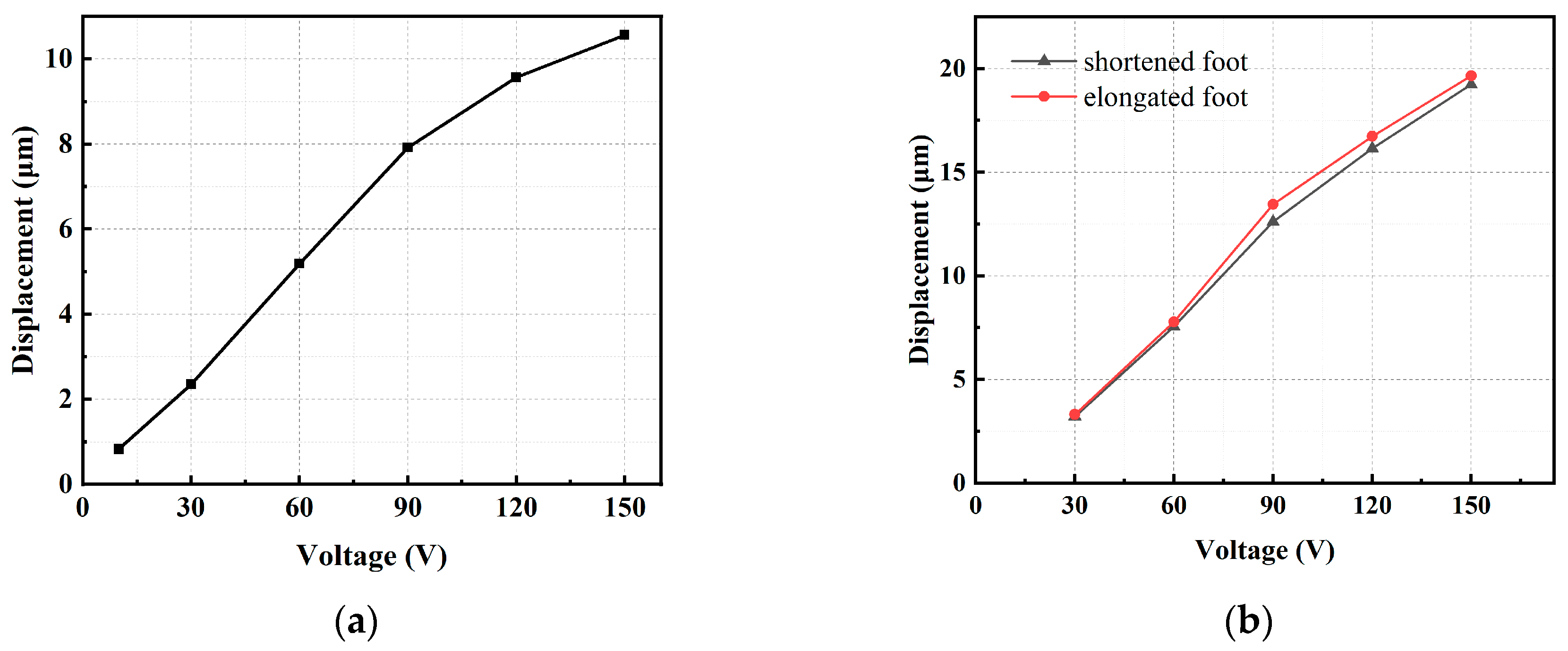
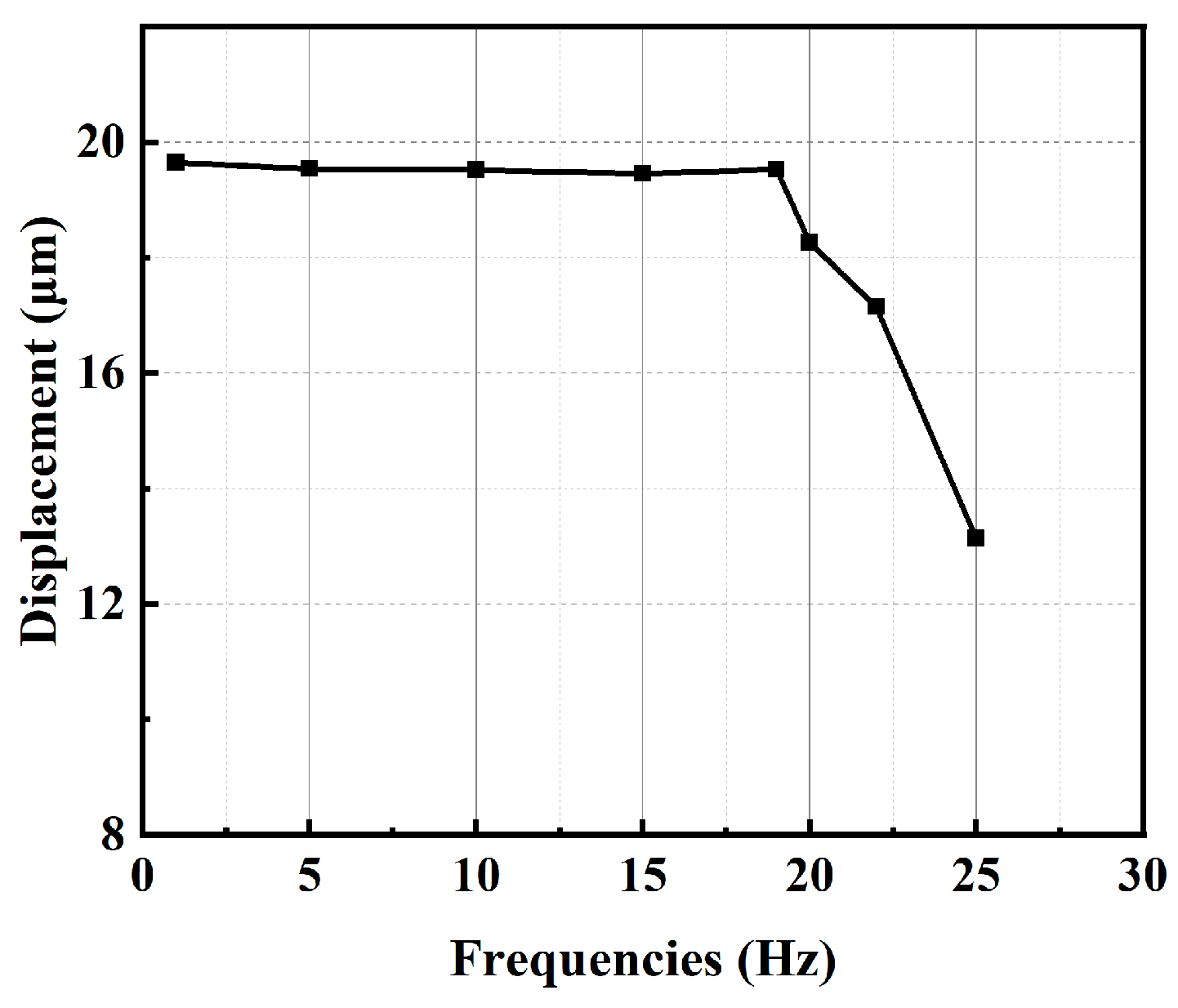

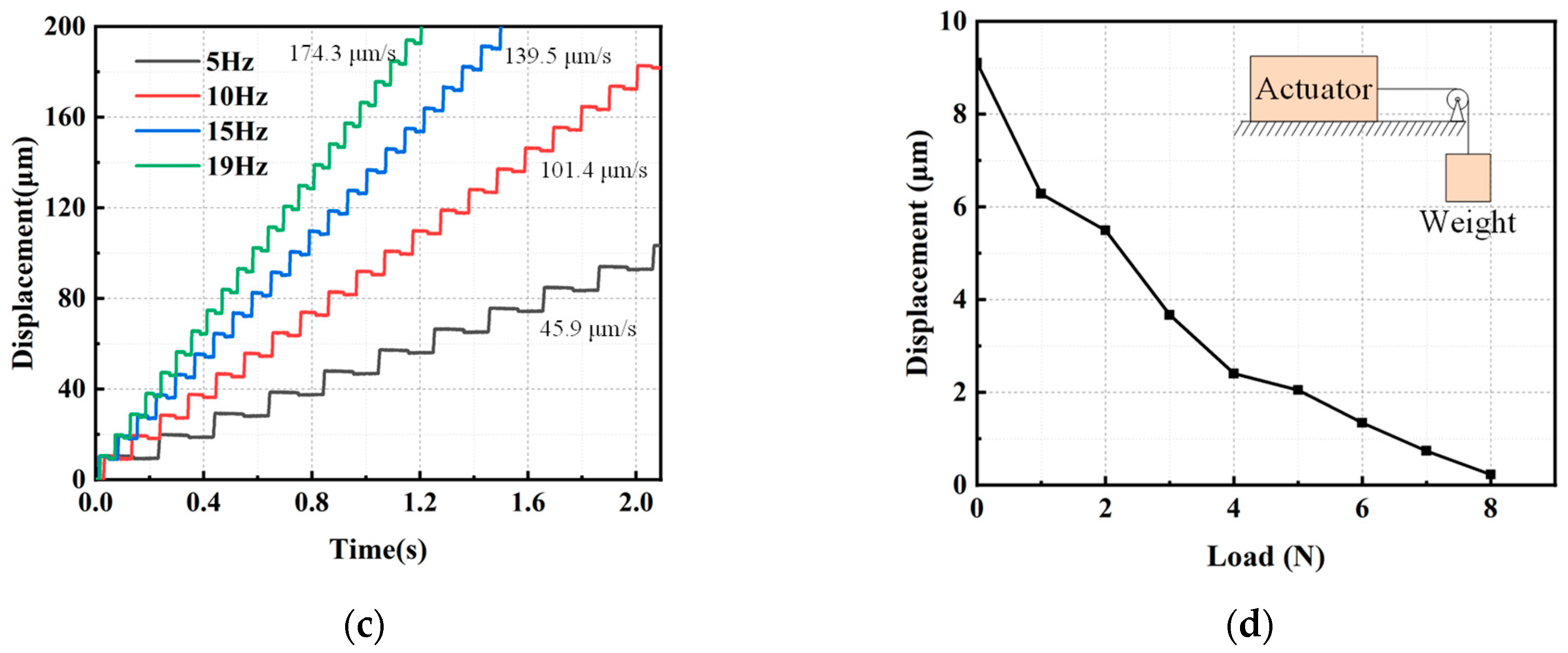
(mm) | (mm) | (°) | Displacement of Elongated Foot (μm) | Displacement of Shortened Foot (μm) | Displacement under 100 N (μm) | Clamping Force (N) |
|---|---|---|---|---|---|---|
| 7 | 1.0 | 25 | 15.9 | 16.8 | 38.0 | 88.4 |
| 7 | 0.8 | 15 | 20.4 | 21.4 | 72.0 | 59.4 |
| 7 | 0.6 | 20 | 22.9 | 22.5 | 148.0 | 30.4 |
| 6 | 1.0 | 15 | 16.8 | 18.9 | 28.6 | 132.1 |
| 6 | 0.8 | 20 | 20.0 | 20.0 | 46.0 | 86.9 |
| 6 | 0.6 | 25 | 19.4 | 19.3 | 96.0 | 40.2 |
| 5 | 1.0 | 20 | 15.9 | 16.9 | 16.0 | 211.3 |
| 5 | 0.8 | 25 | 16.9 | 17.0 | 28.0 | 121.4 |
| 5 | 0.6 | 15 | 25.7 | 25.7 | 66.8 | 76.9 |
| Number of PSAs | Size (mm) | Speed (mm/s) | Output Force (N) | |
|---|---|---|---|---|
| Mohammad et al. [18] | 3 | 115 × 100 × 57.25 | 5.4 | 8.8 |
| Dong et al. [19] | 3 | 150 × 45 × 30 | 0.72 | N/A |
| Wang et al. [20] | 2 | 120 × 120 × 25 | 0.22 | 1.2 |
| Ma et al. [21] | 2 | 61 × 29 × 7 | 0.47 | 11.76 |
| Lu et al. [23] | 1 | N/A | 1.25 | 0.42 |
| Wang et al. [24] | 1 | N/A | 0.00077 | 3.4 |
| This study | 2 | 60 × 45 × 14 | 0.17 | 8.6 |
Disclaimer/Publisher’s Note: The statements, opinions and data contained in all publications are solely those of the individual author(s) and contributor(s) and not of MDPI and/or the editor(s). MDPI and/or the editor(s) disclaim responsibility for any injury to people or property resulting from any ideas, methods, instructions or products referred to in the content. |
© 2024 by the authors. Licensee MDPI, Basel, Switzerland. This article is an open access article distributed under the terms and conditions of the Creative Commons Attribution (CC BY) license (https://creativecommons.org/licenses/by/4.0/).
Share and Cite
Liu, L.; Ji, Z.; Zhang, Y.; Chen, H.; Lou, W.; Kong, M. A Single-Clamp Inchworm Actuator with Two Piezoelectric Stacks. Micromachines 2024, 15, 718. https://doi.org/10.3390/mi15060718
Liu L, Ji Z, Zhang Y, Chen H, Lou W, Kong M. A Single-Clamp Inchworm Actuator with Two Piezoelectric Stacks. Micromachines. 2024; 15(6):718. https://doi.org/10.3390/mi15060718
Chicago/Turabian StyleLiu, Lu, Zheyang Ji, Yue Zhang, Huan Chen, Weimin Lou, and Ming Kong. 2024. "A Single-Clamp Inchworm Actuator with Two Piezoelectric Stacks" Micromachines 15, no. 6: 718. https://doi.org/10.3390/mi15060718





